|
 
Tractate 6 : The Error of Kant (continued)
Metaphysics can, like other minor points with phenomenal potential, be suppressed.
The Aristotelian system was Greek, but the Judeo-Christian story of creation was Semitic – and Semites didn’t have such a fear of the void. The very act of creation was out of a chaotic void, and theologians like Saint Augustine who lived in the fourth century, tried to explain it {nothingness} away by referring to the state before creation as ‘a nothing something’ that is empty of form but yet ‘falls short of utter nothingness.’ The fear of the void was so great that Christian scholars tried to fix the Bible to match Aristotle rather than vice versa. (Tom Rockmore, Before and After Hegel, University of California Press, 1993, p 61.)
But metaphysics, like nothingness, is simply a concept. Metaphysics is the study of what lies outside the physical and the interaction of the two: the physical and what lies outside the physical. It must be acknowledged here, at this point, that philosophy, science, and religion, have all three attempted to complicate the study of metaphysics. All three have attempted to cling to either a Kantian or an Aristotelian perception.
The problem generated by insisting upon one or the other perception can be eliminated in one simple move: Fuse the two. Fuse the Kantian and Aristotelian systems into one system: A non-Cartesian system powered by a Cartesian system.
Such a process gives us:
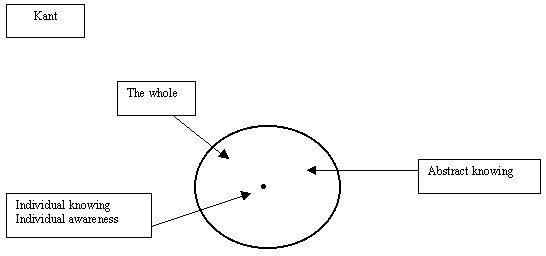
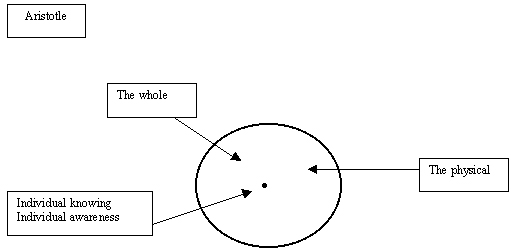
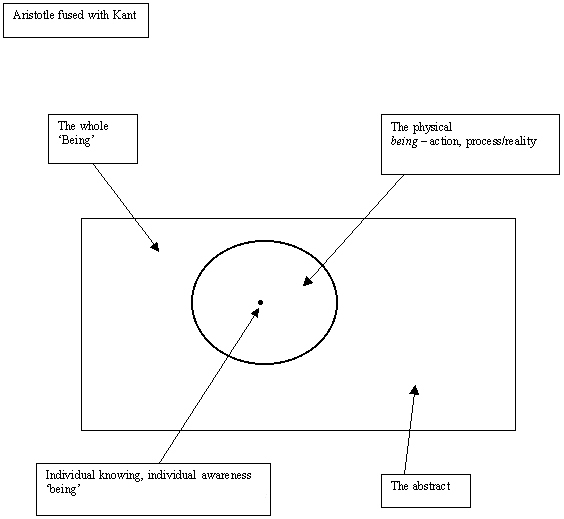
The result: Kant ‘saw’ beyond Aristotle. Kant’s system remains intact. Aristotle’s system remains intact.
The result: ‘being’ being ‘Being’
With the understanding that the whole is the sum of its parts merged with the understanding of ‘a’ ‘system’ being active versus passive, in other words, not just existing but existing in a dynamic fashion, we obtain a system where the whole interacts with its parts and the parts simultaneously interact with the whole. Such a dynamic system becomes symbiotic in nature. As such we obtain a system where the whole is no longer equal to the sum of its parts but rather becomes ‘greater’ than the sum of its parts. Such a system, the Kantian merged with the Aristotelian, ‘being’ being ‘Being, might, in a fusion of cosmological and ontological concepts, be termed: symbiotic panentheism.
In tractates 0 – 5, we have examined such a system in terms of its capability to resolve paradoxes evolving out of perceptions ‘nothingness’, abstraction/Zeno, physicality/Aristotle, divine foreknowledgeBoethius, Centricism/Copernicus, and omni-benevolence/Leibniz brought to the dialectics of philosophy, science, and religion. Now we are going to examine how such a ‘metaphysical’ system can resolve categorical imperatives’/Kant’s dilemma while simultaneously acknowledging the genius of Kant.
The power of fusion thus initiates of a third metaphysical system (the first being the Aristotelian metaphysical system and the second being the Kantian metaphysical system): a non-Cartesian system powered by a Cartesian system.
At one point we ‘believed’ Aristotle’s system was ‘the’ system. Later we ‘believed’ Kant’s system was ‘the’ system. If it is true that history repeats itself, with the fusion of the two, we will once again fall into the error of ‘believing’ that the fusion of the two systems is ‘the’ system. Let’s not delude ourselves a third time, however. We have not come to the end of metaphysics. Metaphysics is simply at the end of the beginning and about to enter the beginning of the ‘body’ of its work. Metaphysics is about to enter its most interesting of times, is about to write the transitional statement leading from Chapter one of metaphysics to chapter two of metaphysics found within the history book of metaphysics itself.
Part II: Resolving the issue with a new metaphysical perception
Metaphysics and Cartesianism revisited
We come back again to the concept of systems. Do we really need a system, as Kant believed to be the case? We will not belabor the point other than to make a few pertinent comments.
First:
If we accept Kant’s perception that we should be able to explain the concepts of metaphysics through the process of modeling a system, then it is a model, a system, we must seek.
Second:
If we claim a system is not necessary, then it is a ‘system less’ system we must seek but that in itself is a form of system. A ‘system less’ system is the most minimalist form of system.
Third:
Kant suggested: If we do not accept his system then we must proceed to establish another system.
All three issues are what are being addressed within this tractate. An alternative system to Kant’s system as well as an alternative system to Aristotle’s system is being proposed. As one examines the new system, one may object to the suggestion that a new system is being proposed. Such objections are invalid. As much as it may seem that the newly proposed system is but a fusion of two system, the Aristotelian system and the Kantian system, one must not lose track of the fact that Kant’s system was simply a modification of Aristotle’s system.
Kant moved Aristotle’s closed system of passive action into being a closed system of active action. Kant moved the concept of time from the Aristotelian concept of being located within reality into time being located within the individual.
Metaphysics is no different than science or religion in terms of progressive growth. Metaphysical growth is simply the advancement of what it was we understood, into being something we now understand to exist. Thus for Kant to advance Aristotle’s metaphysical system from being a closed passive system of action into being a closed active system of action, is no more valid or invalid in terms of advancing metaphysical understanding than to advance Kant’s system of a closed active system into being an open passive system powered by an closed active system which exists as a subset of the open passive system.
The significance of this new system:
- Not only does the concept of system remain intact but now the system itself becomes a ‘growing’ dynamic system in and of itself while retaining both concepts of passivity and action.
- There is now an independent location for limited time
- There is now an independent location for endless time
- There is now an independent location within which ‘nothingness’ can logically be placed
- There is now an independent location within which the infinite can be placed
- Aristotle’s system remains intact
- Kant’s system remains intact
In addition, and not any less significantly, this new system now finds itself accommodating free will. Free will now finds two regions from which it emanates:

Whether or not the physical universe has free will of its own is not the question of metaphysics. Such a question is a question of cosmology and ontology.
In addition, this new system now finds itself accommodating determinism. Determinism now finds two regions from which it emanates:

Whether or not the whole exerts its free will in a deterministic fashion ‘within’ the physical universe is also not the question of metaphysics. Such a question is a question of ontology and cosmology versus it being the question of the reverse nature, of cosmology and ontology, as the previous diagram regarding free will suggested vis-à-vis free will of the universe as an entity.
To make such limited claims as to the responsibility of metaphysics is by no means shirking the duty of metaphysics but rather further defining the very responsibility to which metaphysics must look. Metaphysics is the study of what lies ‘beyond’/’outside’ – ‘the physical’ and the interrelationship of such a region to ourselves and ourselves to it.
Metaphysics is not a study of what lies beyond the physical and how such a region interacts with the physical itself, nor is metaphysics the study of what occurs ‘after’ the physical no longer exists should such an occurrence be possible.
But what of Metaphysics and Cartesianism? What exactly does this have to do with Metaphysics and Cartesianism themselves?
Metaphysics
Over and over we come back to the concept of metaphysics: Meta - beyond, physics – the physical. Again and again one responds: We can never understand such a region for it lies beyond what we have ‘seen’ and therefore must ‘contain’ what it is which lies beyond our ability to ‘ever’ ‘see’.
Be that as it may, we did not let this perception stop us from hypothesizing what lay ‘inside’ the atom. We did not let such a perception stop us from hypothesizing what lay ‘inside’ a neutron. We did not let such a perception stop us from hypothesizing what lay inside a ‘quark’.
Metaphysics: the study of what lies beyond the physical.
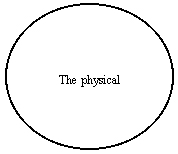
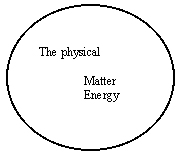
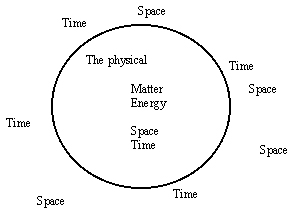
Upon close scrutiny we know this to be an inaccurate depiction for space and time have been identified as fabrics of the universe. Therefore if space and time were where we said they were in the former diagram, we would have to expand the boundaries of the universe to include them, giving us:
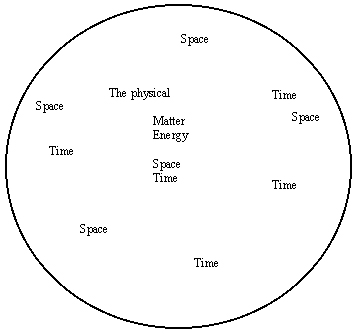
Does this mean space and time, matter and energy, cannot be found ‘outside the physical/the universe? Yes and no. Matter and energy, space and time cannot be found ‘outside’ the physical/the universe in the form of being the ‘fabric’, which exists as ‘the fabric’, which lies outside the physical/the universe just as ‘the fabric’ of what lies ‘outside’ the physical/the universe cannot be ‘the fabric’ of what lies ‘inside’ the physical/the universe. If ‘the fabric’ of the physical lay ‘outside’ the physical/the universe:
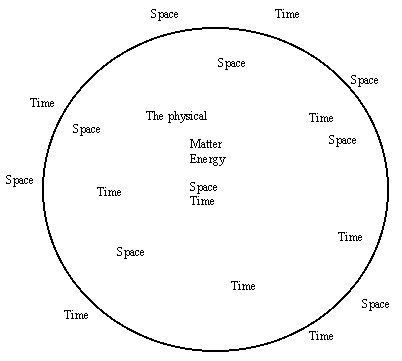
we would simply have to expand the physical/the universe once again:
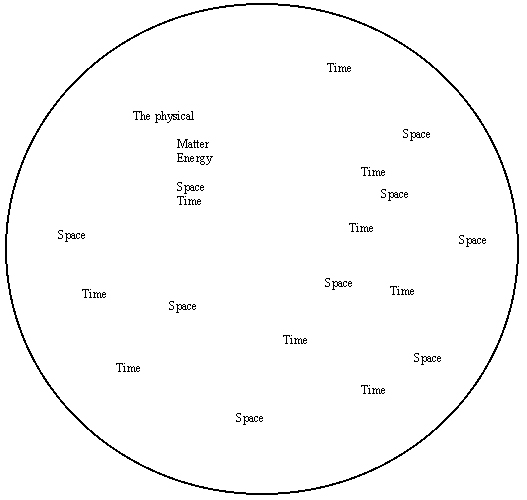
So is there any way to ‘know’ what lies ‘outside’, what lies ‘beyond’ the boundary of the physical/the universe
From the given argument we can make a fairly good guess, hypothesize, as to what lies beyond the physical/the universe. We can be fairly certain that what acts as the fabric of what lies ‘beyond’ the physical/the universe is not a fabric of space and time, matter and energy.
But what type of fabric could exist other than space and time, matter and energy? Zeno gives us a good insight into an alternative fabric to space and time, matter and energy.
Space and time, matter and energy, spawn a product of cause and effect. Therefore lets now diagram what we perceive to be the physical composed of a space/time, matter/energy fabric and examine the results. To do so we will need to reduce the ‘apparent’ size of the physical/the universe in order to place what lies ‘beyond’ the universe in its appropriate location relative to the diagram:
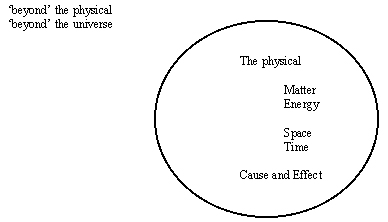
To assist our need to focus upon the task of examining what lies ‘beyond’ the physical/the universe, we will enclose what lies ‘beyond’ the physical and as such we obtain:
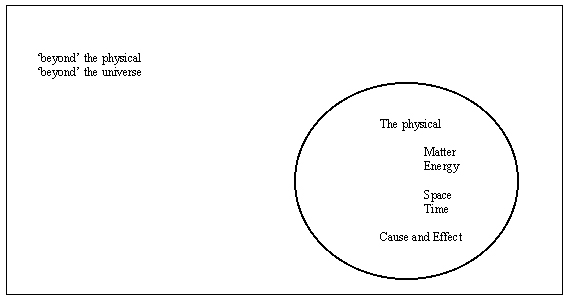
Now we know space and time are not the fabric of what lies beyond the physical, therefore we obtain:
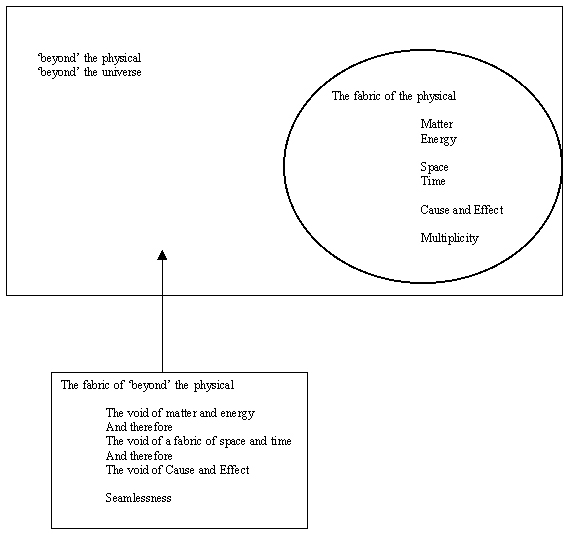
We now once again come back to Zeno and his concepts of seamlessness and multiplicity. But rather than obtain Zeno’s concept of there being only ‘one’ location we find we have ‘two’ locations. The physical/the universe finds itself containing the fabric of cause and effect generated by matter and energy explaining Zeno’s multiplicity and the second location, ‘beyond’ the physical/the universe, containing a fabric void cause and effect generated by matter and energy because matter and energy are aspects of the physical/multiplicity and thus we obtain a fabric of seamlessness generated by the lack of matter and energy, space and time, and cause and effect.
Once again the question: What lies ‘beyond’ the physical? Put more specifically: What lies ‘beyond’ the Cartesianism. The answer: What lies ‘beyond’ the Cartesian is the non-Cartesian.
Cartesianism: Cause and effect, beginning and end, a foundation based sub-system.
Non-Cartesianism: No cause and effect, no beginning and no end, a foundationless set.
Cause and effect, cause and effect, cause and effect: is the primary concept of Cartesianism – beginning/end, concepts
‘a’ foundation:
Aristotle states that we are immersed within space and time from which emerges the concept of passive observation. Kant states that we are not immersed in space and time but rather that time and space are immersed in us from which emerges the concept of active observation.
In order to establish which is correct and thus take the subsequent step of ‘building’ a model of one’s metaphysical system, one appears to then have little choice but to choose which is correct: Are we immersed in space and time or is space and time immersed within ourselves.
The obvious, however, is not always the most appropriate choice. There is a second, less obvious, choice. One can accept the accuracy of both and then establish one’s metaphysical model. That is precisely what the system of ‘being’ being ‘Being’ does.
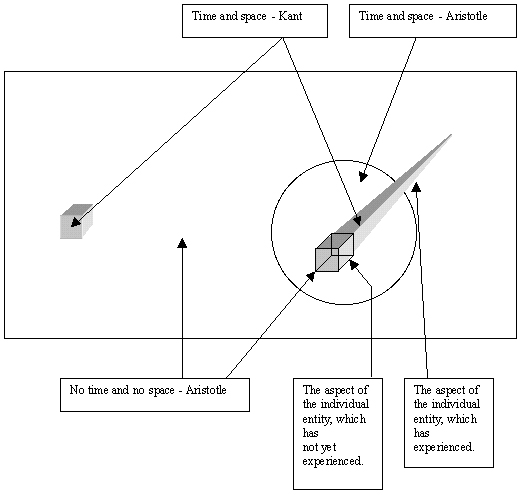
So it is, time and space are found within us and likewise we are found within time and space
We understand how we travel through space and time, but how does space and time become a part of our abstractual existence? Time and space become a part of our abstractual existence through our experiencing events within the parameters of space and time themselves. This begins with ‘virgin consciousness’ and ends wherever the ending of the travel through space and time may find itself to be.
Kant was at a loss to establish his system as a system for he perceived his system to be a modification of the Aristotelian system. In other words Kant perceived the universe to be the system. In addition Kant perceived his system to simply invert the Aristotelian system from being one of passivity to being one of action. The system, however, remained bound within the Aristotelian concept of being ‘the’ universe.
Because Kant’s system remained bound in Kant’s perception of ‘contemporary bounds’, Kant could not find ‘a’ foundation, ‘a’ first truth, ‘a’ first cause, ‘a’ ….
With the new metaphysical system fusing Aristotle’s system with Kant’s system, ‘a’ foundation, ‘a’ first truth, etc now become multiple ‘first’ truths, multiple ‘first’ foundations based upon the concept of relativistic first principles established in detail within Tractate 2: Aristotle and Cartesianism.
Kant’s quandary of being unable to establish which of the concepts, Causation exists, the universe exists, or I exist, is ‘the’ foundation upon which the other truths emerge disappears as a dilemma with the establishment of a metaphysical system where the three exists in separate locations as ‘the’ base foundation of their own existence:
‘being’ being ‘Being’
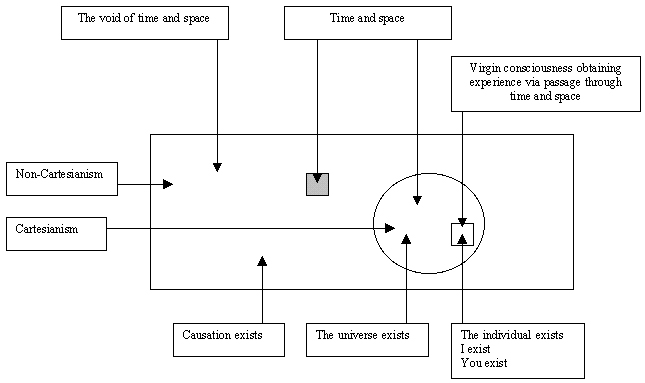
With such a system Kant no longer need find ‘a’ 1st principle for three 1st principles exist equally relative one to the other. Once again, for a more detailed explanation of the concept of relativistic 1st principle one should refer to Tractate 2: Aristotle and Cartesianism.
This then brings us to the concept of why we need ‘a whole’.
The need for ‘a’ whole
We perceive there to be three aspects to time: the past, the present, and the future.
Such a perception leads us to the false perception that metaphysical perceptions are limited to three forms of possibilities: what was, what is, and what will be.
Such a perception, added to our perception of the universe being the only ‘location’, leads to chaos and thus confusion:
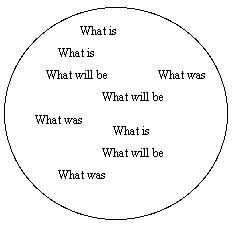
The confusion is one of our own making. As such the chaos generated by confusion can be methodically organized by ourselves to bring order out of chaos. The order, however, can only be accomplished through the introduction of an additional metaphysical perception regarding time.
If we reexamine our perception of time we will see that in truth there are only two aspects of time: The present and the future. At first glance, such a statement would imply a process of subtraction rather than addition to our perceptions of time.
In truth, such a reordering of time creates a perception of time, which leads us to the more accurate perception of time. With such a reordering of time we begin to see time as having two aspects: ‘what is’ and ‘what could’ be
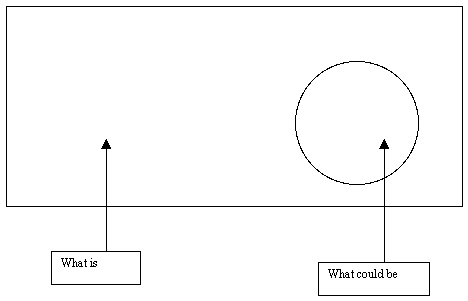
Now why use the phrase ‘what could be’ versus the phrase ‘what will be’?
‘What will be’ indicates that it ‘will be’. Such a statement cannot be denied, and therefore it must already be while it may not yet be. The result: What will be ‘is’ and as such simply is a part of ‘what is’. ‘What will be’ is not ‘potentiality’ but rather predetermined and thus lies in the fabric of timelessness and spacelessness. ‘What will be’ is a part of what lies ‘beyond’ the physical/the universe.
What lies ‘within’ the fabric of space/time, cause and effect is "what ‘could’ be", potentiality. The cause will lead to an effect. In terms of the physical/multiplicity the effect is predictable. In terms of the non-physical/seamlessness/abstraction the effect is unpredictable, has potentiality of becoming what is not predictable.
|
|
|





















